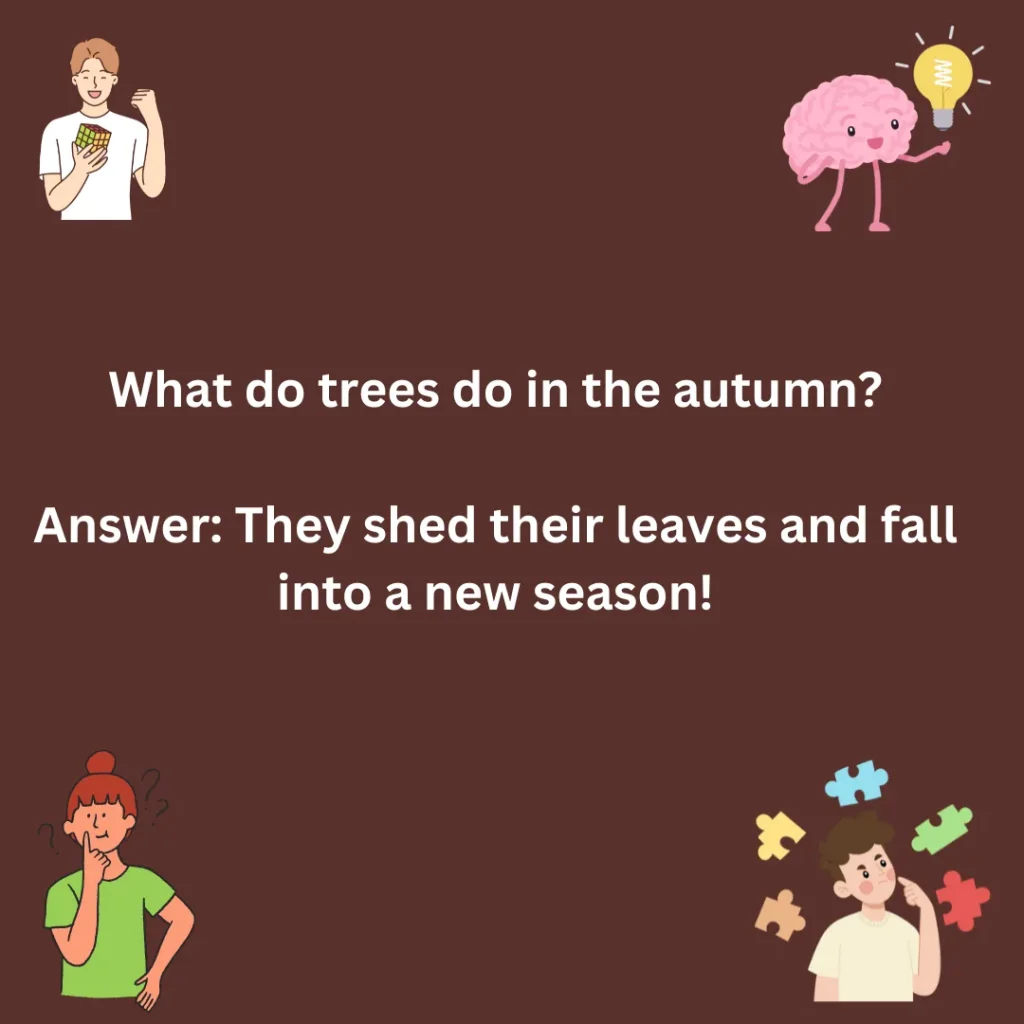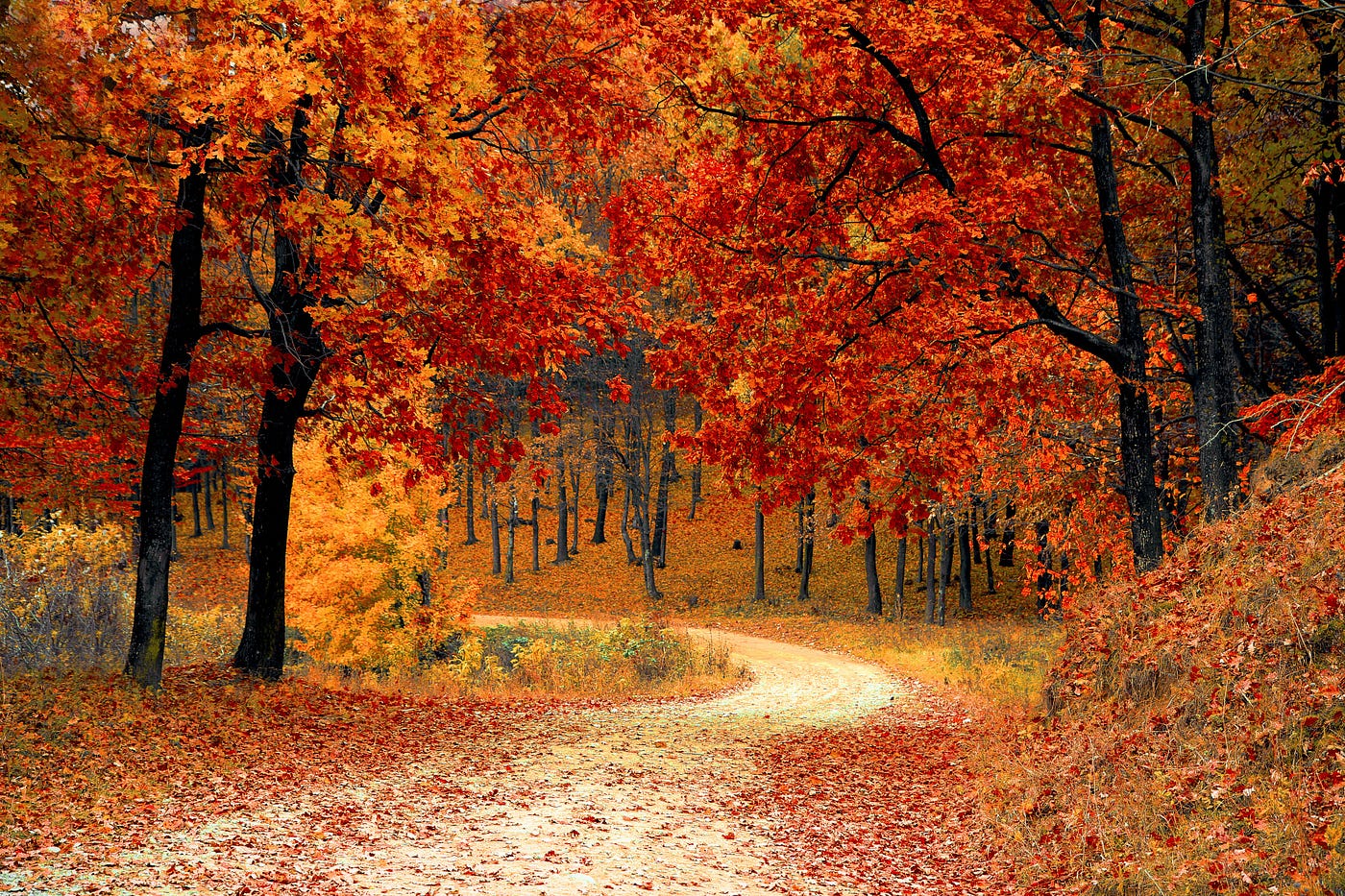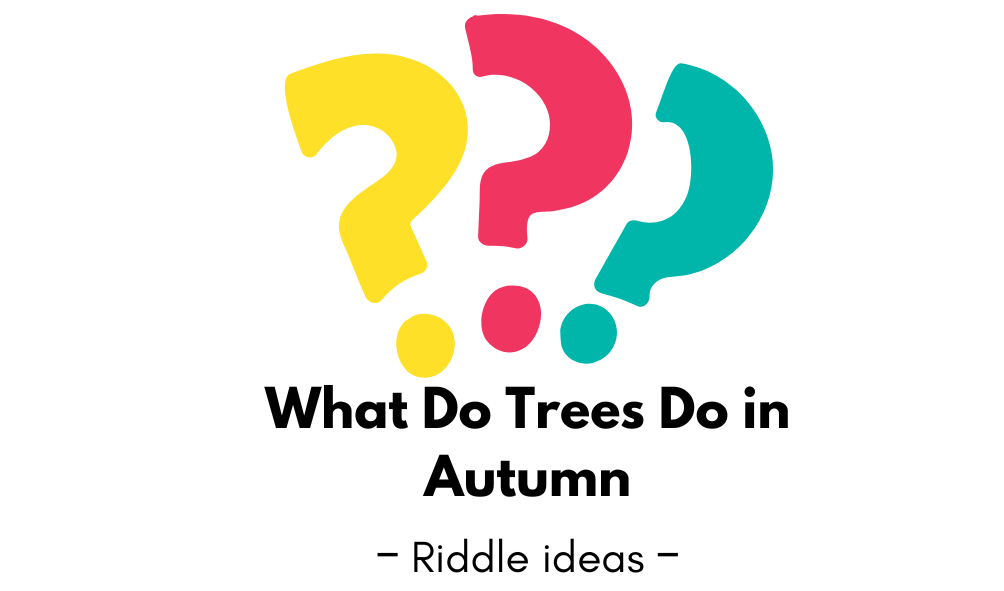As summer fades away, trees undergo a magical transformation, painting the world in shades of red, orange, yellow, and gold.
But have you ever wondered why leaves change color and fall? This natural phenomenon isn’t just for beauty—it’s a survival strategy!
In autumn, trees prepare for winter by stopping the production of chlorophyll, the pigment that gives leaves their green color.
As chlorophyll fades, hidden pigments like carotenoids and anthocyanins emerge, creating the stunning fall colors we love.
Eventually, trees shed their leaves to conserve energy and protect themselves from winter’s harsh conditions.
Try this riddle:
I stand tall and proud with leaves so bright,
But when cold winds blow, I take my flight.
I shed my colors, one by one,
Until my leafy coat is gone.
What am I?
Can You Solve This Tree Riddle?


Autumn brings a world of crisp air, golden leaves, and cozy vibes—but have you ever stopped to wonder about the mystery of trees in fall? Let’s test your brain with this fun riddle!
Riddle:
I stand so tall with arms so wide,
In summer, I give you shade to hide.
But when the chilly winds arrive,
My golden coat won’t long survive.
What am I?
Think you know the answer? Scroll down to see if you’re right!
(Answer: A tree in autumn!)
Why Do Trees Change Colors in Fall?
As summer fades, trees begin their breathtaking transformation—turning vibrant shades of red, orange, yellow, and gold. But why does this happen? The secret lies in science and survival!
The Science Behind the Colors
During warmer months, leaves are green because of chlorophyll, the pigment that helps trees absorb sunlight for photosynthesis. But in autumn:
Chlorophyll breaks down as trees prepare for winter.
Hidden pigments emerge—carotenoids (yellow/orange) and anthocyanins (red/purple).
Trees shed their leaves to conserve water and energy for the cold months ahead.
The Secret Behind Falling Leaves


Every autumn, trees shed their leaves, creating a breathtaking display of red, orange, and gold. But have you ever wondered why leaves fall in the first place? The answer lies in science and survival!
Why Do Leaves Fall?
Energy Conservation: In winter, trees slow down food production to survive the cold.
Chlorophyll Breakdown: The green pigment fades away, revealing hidden autumn colors.
Self-Protection: Trees seal off their leaves to prevent water loss and avoid freezing damage.
A Fun Riddle for You!
I dance to the ground without a sound,
Once bright and green, now gold and brown.
I wave goodbye as winter nears,
Floating softly, light as air.
What am I?
(Answer: A falling autumn leaf!)
Fun Riddle About Trees in Autumn
Autumn brings a world of color, change, and mystery—can you solve this seasonal riddle?
Riddle:
I wear a coat of green all year,
Then trade it in when fall is near.
I dress in red, gold, and brown,
Before my leaves come tumbling down.
What am I?
(Answer: A tree in autumn!)
Nature’s Magic: How Trees Prepare for Winter


As the air turns crisp and daylight fades, trees begin their magical transformation to survive the winter months. But how do they do it?
The Science Behind the Change
Shedding Leaves – Trees drop their leaves to conserve energy and prevent water loss.
Color Transformation – As chlorophyll fades, hidden pigments like carotenoids (yellow/orange) and anthocyanins (red/purple) emerge.
Dormancy Mode – Trees slow down their metabolism, almost like hibernation, to endure the cold.
Bark Protection – A tree’s bark thickens, acting like a natural coat to keep moisture inside.
A Fun Tree Riddle for You!
In summer, I stand so tall and bright,
With leafy arms that catch the light.
But when cold winds begin to call,
I shed my coat and let leaves fall.
What am I?
(Answer: A tree preparing for winter!)
Autumn Trivia: What Happens to Trees in Fall?
Autumn is a season of change, color, and preparation. But do you know what actually happens to trees during this time? Test your knowledge with these fun facts!
Autumn Tree Trivia
Why do leaves change color?
Trees stop producing chlorophyll, revealing hidden pigments like carotenoids (yellow/orange) and anthocyanins (red/purple).
Why do trees shed their leaves?
To conserve water and energy for the winter months, trees seal off their leaves, causing them to fall.
Do all trees lose their leaves?
No! Deciduous trees (like maples and oaks) shed leaves, while evergreens (like pines and firs) keep their needles all year.
Can You Solve This Autumn Riddle?
I start off green and full of life,
But chilly air brings change and strife.
I turn to gold, red, and brown,
Then gently drift down to the ground.
What am I?
(Answer: A falling autumn leaf!)
A Clever Riddle About Leaves Changing Color
Autumn is full of mystery and magic, and so is this riddle! Can you figure it out?
Riddle:
I start off green and full of life,
Basking in the sun so bright.
But as the air turns crisp and cool,
I trade my shade for fiery hues.
Red, gold, and orange I become,
Then float away—my job is done.
What am I?
(Answer: A leaf changing color in autumn!)
Fun Facts About Autumn Trees
-
Leaves Don’t Change Color—They Reveal It!
Leaves are always red, orange, and yellow underneath, but during summer, green chlorophyll hides those colors. In fall, as chlorophyll fades, the hidden hues emerge!
-
Trees Drop Their Leaves to Survive Winter
Deciduous trees shed leaves to conserve water and energy for the colder months ahead. Without leaves, trees are less likely to freeze or dry out.
-
Sunny Days and Cool Nights Make Brighter Leaves
The most vibrant autumn colors happen when days are sunny and warm, but nights are cool without frost.
-
Not All Trees Lose Their Leaves
Evergreen trees like pines and spruces keep their needles year-round, while deciduous trees (like maples and oaks) lose their leaves.
-
Some Trees Take Longer to Lose Their Leaves
Oak trees often keep their brown leaves deep into winter, while maples and birches shed them much earlier.
Frequently Asked Questions About Autumn Trees
Why do leaves change color in autumn?
Leaves change color because trees stop producing chlorophyll (the green pigment). This allows hidden colors like red, orange, and yellow to appear!
Why do trees lose their leaves in fall?
Trees drop their leaves to conserve water and energy for winter. This also prevents leaves from freezing and breaking under snow or ice.
Do all trees lose their leaves in autumn?
No! Deciduous trees (like oaks and maples) shed their leaves, while evergreens (like pines and firs) keep their needles year-round.
What makes fall leaves more colorful?
Sunny days and cool nights help produce the most vibrant autumn colors! Too much rain or an early frost can dull the colors.
Conclusion About Autumn Trees
Autumn trees are one of nature’s most breathtaking transformations. As the days grow shorter and temperatures drop, trees prepare for winter by revealing hidden colors, shedding their leaves, and conserving energy.
The vibrant reds, oranges, and yellows we admire in fall are always present in the leaves, but they become visible as chlorophyll fades.
This seasonal change is not just beautiful—it’s essential for trees to survive colder months. Deciduous trees let go of their leaves, while evergreens stay green all year, adapting in their own way.
Understanding autumn trees helps us appreciate their natural cycle and the science behind the beauty.
Whether it’s watching the leaves change, solving a tree riddle, or simply enjoying a crisp fall day, autumn trees remind us of the wonder and wisdom of nature.


